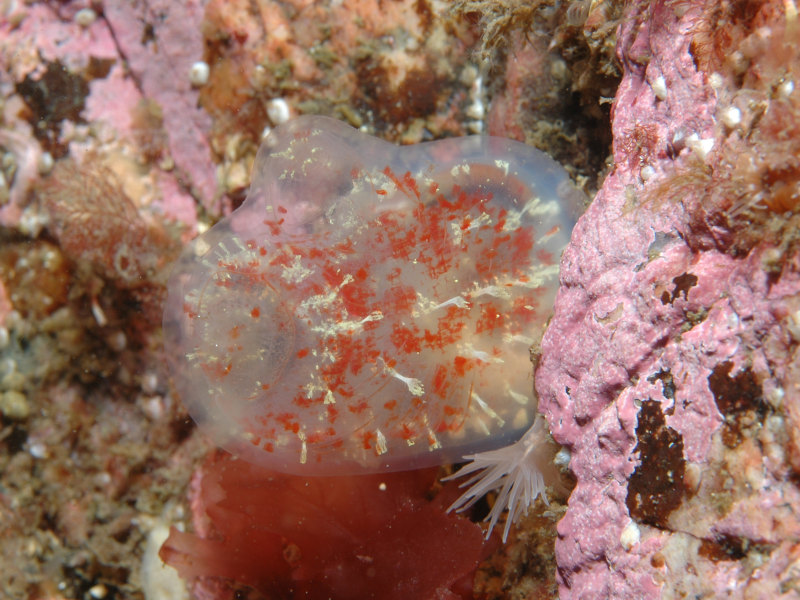Gas-mantle ascidian (Corella parallelogramma)
Distribution data supplied by the Ocean Biodiversity Information System (OBIS). To interrogate UK data visit the NBN Atlas.Map Help
| Researched by | Eliza Gibson-Hall | Refereed by | This information is not refereed |
| Authority | (Müller, 1776) | ||
| Other common names | - | Synonyms | Ascidia parallelogramma Mueller, 1776 |
Summary
Description
This rectangular ascidian is laterally compressed with a thin, transparent test. Corella parallelogramma is 30-50 mm tall and 20-30 mm broad. The branchial sac (gill) and gut are clearly visible. The branchial sac is commonly marked with yellow and/or red pigments occurring in a criss-cross pattern. The gut is located to the right of the branchial sac. The intestine can be seen as a grey tube running along the base and up the side of the body. Gonads occur either in or around the intestinal loop. The atrial siphon is usually short but for some individuals, it is very long. Oral siphons have red eyespots (ocelli). It attaches itself to substratum via a small part of its base. This is a unitary species.
Recorded distribution in Britain and Ireland
Recorded around the entire British Isles.
Global distribution
Records from the British Isles, North Sea, Norway to the Mediterranean. There is a single record in the Gulf of Alaska and recorded above Norway in the Arctic Circle.
Habitat
Found from shallow water to 200 m. Grows on rocks, stones, shells, and Laminaria, preferring clear water. This species likes a fair amount of water movement and therefore, usually occurs in areas of strong currents.
Depth range
Shallow water - 200 mIdentifying features
- Its test is thin and transparent
- Rectangular shaped body with a flattened base; 30-50 mm tall and 20-30 mm broad.
- Its internal organs are visible
- The branchial sac is commonly marked with yellow/red pigments
Additional information
No other ascidian species is the same shape as Corella parallelogramma or as transparent. The most similar species is Ascidiella scabra which is only partially transparent with some coloured markings on the branchial sac.
Listed by
- none -
Bibliography
De Kluijver, M.J. & Ingalsuo, S.S., 2018. Corella parallelogramma. Macrobenthos of the North Sea - tunicata marine species identification portal ETI bioinformatics. (20.07.18). http://species-identification.org/species.php?species_group=tunicata&id=25
Hayward, P.J. & Ryland, J.S. (ed.) 1995b. Handbook of the marine fauna of North-West Europe. Oxford: Oxford University Press.
Millar, R.H., 1970. British Ascidians London: Academic Press.[Synopses of the British Fauna, no. 1.]
Picton, B.E. & Morrow, C.C., 2016. Corella parallelogramma (O F Müller, 1776). Encyclopedia of marine life of Britain and Ireland, (20.06.2018). http://www.habitas.org.uk/marinelife/species.asp?item=ZD1350
Datasets
NBN (National Biodiversity Network) Atlas. Available from: https://www.nbnatlas.org.
OBIS (Ocean Biodiversity Information System), 2025. Global map of species distribution using gridded data. Available from: Ocean Biogeographic Information System. www.iobis.org. Accessed: 2025-07-30
Citation
This review can be cited as:
Last Updated: 22/08/2018



